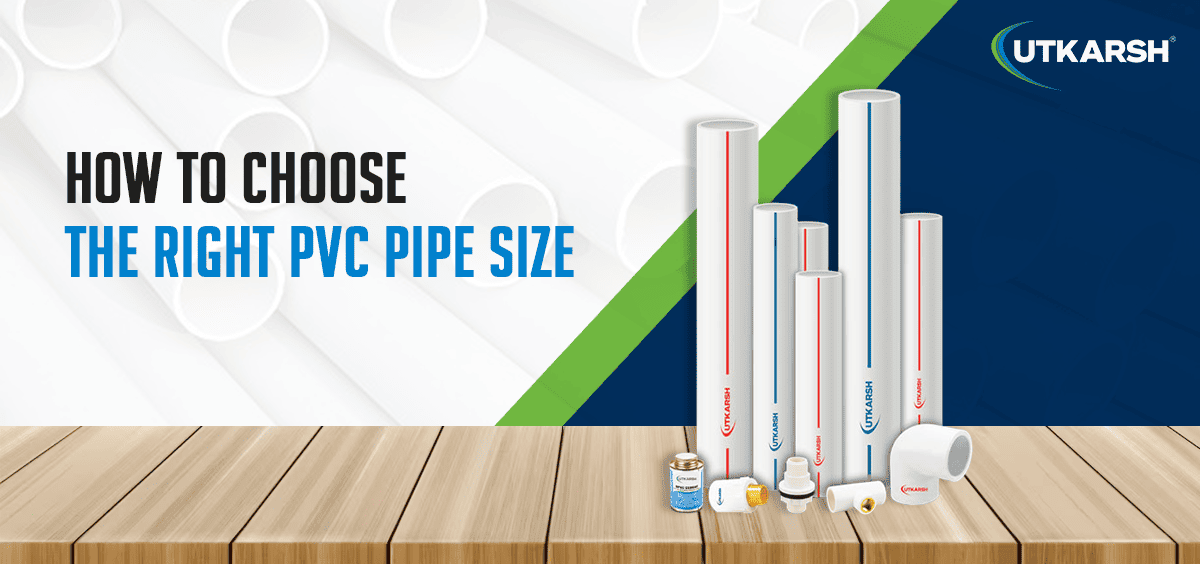How to Choose the Right PVC Pipe Size

PVC pipes are the backbone of various residential and commercial projects, making the selection of the right size a pivotal decision. In this comprehensive guide, we not only delve into the intricacies of choosing the correct PVC pipe size but also explore different types, each tailored for specific applications.
Understanding PVC Pipe Sizes:
When initiating a project involving PVC pipes, understanding the difference between nominal and actual sizes is paramount. PVC pipes come in various schedules, with schedule 40 and schedule 80 being the most common. The nominal size refers to the name of the pipe, while the actual size represents its true dimensions.
Types of PVC Pipes:
PVC pipes come in a diverse array of types, each designed to meet specific needs:
- CPVC (Chlorinated Polyvinyl Chloride): Known for its high-temperature resistance, CPVC is commonly used in hot water systems, ensuring durability and reliability. Common residential sizes typically range from approximately 15mm to 50mm.
- UPVC (Unplasticized Polyvinyl Chloride): Rigid and durable, UPVC pipes are versatile, suitable for both water supply and drainage systems in residential and commercial settings. Common residential sizes usually range from approximately 15mm to 50mm.
- SWR (Soil, Waste, and Rainwater): Specifically designed for drainage systems in buildings, SWR pipes ensure the efficient removal of soil, waste, and rainwater. Common residential sizes typically range from approximately 75mm to 160mm.
- Casing Pipes: Used to encase and protect electrical, water, or gas lines, casing pipes provide insulation and safeguard against external elements. Common sizes for residential purposes usually range from approximately 40mm to 300mm.
- Agriculture Pipes: Tailored for agricultural applications, such as irrigation, these pipes are designed to withstand the demands of farming environments. Common sizes for residential purposes typically range from approximately 40mm to 315mm.
- Column Pipes: Essential for borewell installations, column pipes ensure a reliable and steady water supply for both residential and commercial needs. Common sizes for residential purposes usually range from approximately 15mm to 110mm.
- HDPE Pipes (High-Density Polyethylene): Known for their flexibility and durability, HDPE pipes find applications in various scenarios, including water supply and irrigation. Common commercial or industrial sizes typically range from approximately 16mm to 315mm.
- PLB Ducts (Permanently Lubricated Ducts): Ideal for laying optical fiber cables, PLB ducts provide protection and ease of installation for telecommunication infrastructure. Common commercial and industrial sizes typically range from approximately 50mm to 300mm.
Understanding the specific characteristics, applications, and sizes of each type is crucial for making informed decisions in your project.
Factors Influencing PVC Pipe Size Selection:
Selecting the right PVC pipe size involves a careful consideration of factors such as flow requirements, water pressure, and the specific application of the pipes. Whether it's for irrigation, plumbing, or other purposes, each application demands a unique approach to size selection.
Calculating Flow Rates and Pressure Drop:
Accurate calculations of flow rates and understanding pressure drop are crucial steps in determining the ideal PVC pipe size. This section will guide you through the methods for calculating required flow rates and highlight the importance of managing pressure drop within acceptable limits.
Common Mistakes in PVC Pipe Size Selection:
Explore the pitfalls of oversizing or undersizing PVC pipes and the adverse effects these mistakes can have on the efficiency of your system. Learn from common errors to ensure your project doesn't fall victim to sizing issues.
PVC Pipe Size Chart and Standards:
Navigate the maze of PVC pipe sizes with an overview of standard sizing charts. Ensure compliance with industry standards to guarantee the longevity and reliability of your PVC pipe system.
Choosing the Right PVC Pipe Manufacturer:
A reliable PVC pipe starts with a reputable manufacturer. Utkarsh Pipes, for example, is known for its commitment to quality and innovation. Learn about the key factors to consider when selecting a manufacturer to guarantee the quality and performance of your PVC pipes.
Utkarsh Pipes Sizes for Different Types:
| Pipe Type | Residential Sizes (mm) | Commercial/Industrial Sizes (mm) |
| CPVC | 15-50 | - |
| UPVC | 15-50 | - |
| SWR | 75-160 | - |
| Casing Pipes | 40-300 | 150-250 |
| Agriculture Pipes | 40-315 | 110-160 |
| Column Pipes | 15-110 | - |
| HDPE Pipes | - | 16-315 |
| PLB Ducts | - | 50-300 |
Applications and Industries Using PVC Pipes:
Explore the diverse applications of PVC pipes across various industries. Tailor your pipe size based on the specific requirements of construction, agriculture, plumbing, and more.
Innovations in PVC Pipe Technology:
Stay ahead of the curve by understanding the latest technological advancements in PVC pipe manufacturing. Discover how innovation influences the selection of the right PVC pipe size.
Environmental Considerations:
Examine the eco-friendliness of PVC pipes and the responsible disposal and recycling practices associated with them. Ensure your project aligns with sustainable practices.
Tips for DIY Enthusiasts:
For those engaged in DIY projects involving PVC pipes, this section provides valuable advice and highlights common pitfalls to avoid during the selection process.
Case Studies: Successful PVC Pipe Size Selection:
Real-world examples showcase the impact of proper PVC pipe size selection on project success. Draw lessons from successful projects to enhance your decision-making process.
FAQs:
1. Q: Can I use HDPE pipes for commercial or industrial water supply?
• A: Yes, HDPE pipes are suitable for commercial or industrial water supply due to their flexibility, durability, and ability to handle higher volumes. Common sizes for such purposes typically range from approximately 16mm to 315mm.
2. Q: What sizes of PLB duct pipes are recommended for commercial and industrial applications?
• A: PLB duct pipes ideal for commercial and industrial applications typically come in sizes ranging from approximately 50mm to 300mm, providing protection and ease of installation for telecommunication infrastructure.
3. Q: Can HDPE pipes be used for irrigation in large agricultural setups?
• A: Yes, HDPE pipes with larger sizes, typically ranging from approximately 75mm to 315mm, are suitable for irrigation in large agricultural setups, offering durability and efficient water supply.
4. Q: What factors should be considered when selecting PVC pipes for industrial plumbing systems?
• A: Factors such as pipe material, size, and resistance to chemicals should be carefully considered when selecting PVC pipes for industrial plumbing systems. Consulting with experts can help in making informed choices.
5. Q: What sizes of Utkarsh Pipes are available for different types?
• A: Utkarsh Pipes offers a range of sizes for different types, including CPVC, UPVC, SWR, Casing Pipes, Agriculture Pipes, and Column Pipes. For specific details, it is recommended to contact Utkarsh Pipes directly.
6. Q: Are there specific standards for PVC pipes used in industrial applications?
• A: Yes, there are industry standards that define the specifications for PVC pipes used in industrial applications. It is crucial to adhere to these standards to ensure the reliability and longevity of the piping system.
7. Q: How does the flexibility of HDPE pipes contribute to their use in industrial settings?
• A: The flexibility of HDPE pipes allows for easy installation, even in complex industrial environments. This flexibility, combined with their durability, makes HDPE pipes a preferred choice in many industrial applications.
8. Q: Are there specialized fittings available for connecting different sizes of PVC pipes in industrial projects?
• A: Yes, there are a variety of fittings designed for connecting different sizes of PVC pipes in industrial projects. These fittings ensure a secure and leak-free connection, maintaining the integrity of the piping system.
9. Q: What considerations should be taken into account when choosing PLB duct pipes for large-scale telecommunication projects?
• A: Considerations include the size of the ducts, ease of installation, and protection against environmental factors. PLB duct pipes with sizes ranging from approximately 50mm to 300mm are commonly used for such projects.
10. Q: Can PVC pipes be used in both residential plumbing and industrial applications?
• A: Yes, PVC pipes are versatile and can be used in both residential plumbing and industrial applications, provided the appropriate size and type are selected based on the specific requirements of each project.
Conclusion
In conclusion, the importance of choosing the right PVC pipe size, considering the diverse types available, cannot be overstated. From understanding nominal and actual sizes to calculating flow rates, each step is crucial. By considering the factors outlined in this blog, you'll be better equipped to make informed decisions that contribute to the success and efficiency of your project.












